African ferns help to create astonishing aquascapes. These emerged plants have various unique properties and aquascaping aspects. This article will discuss Bolbitis heudelotii’s introduction and how to build a bolbitis heudelotii aquascape. Different suitable styles are also a part of the discussion with care aspects. It will also cover a comparison between Bolbitis difformis and Bolbitis heudelotii. Scroll down to read in detail.
Content Table
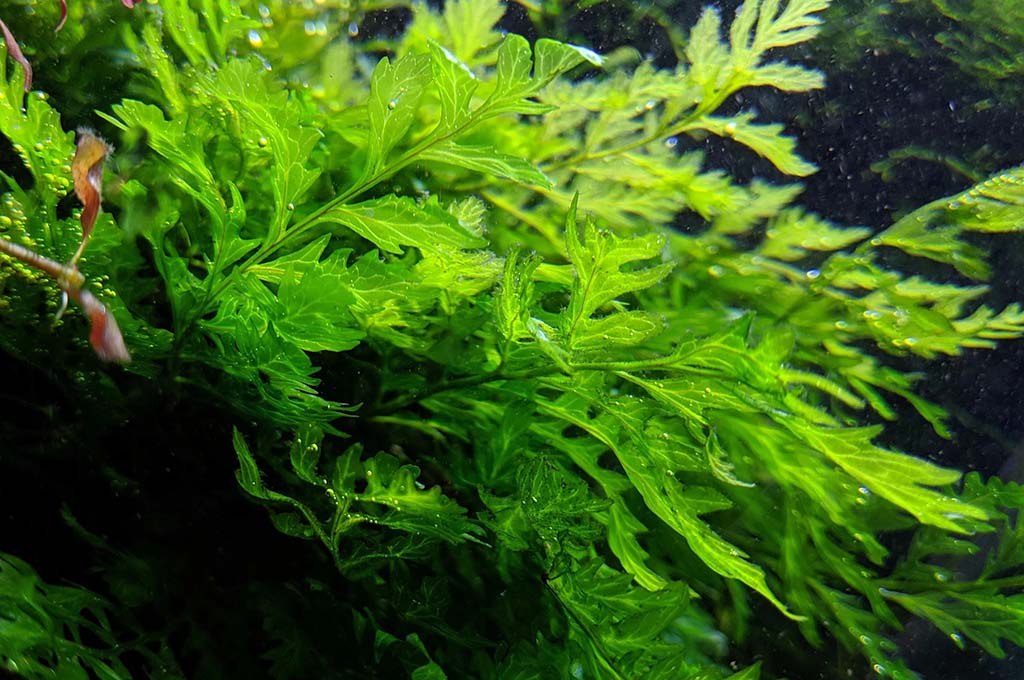
Bolbitis heudelotii
Bolbitis Heudelotii
Bolbitis heudelotii, or African water fern, is a creeping fern that grows in submerged conditions. Congo fern is another common name for this true fern. Tropical and subtropical regions of Africa, i.e., West Ethiopia, Senegal, Northern African regions, etc., are their native habitats. Jean-Pierre Heudelot, a botanical explorer, discovered this creeping fern in West Africa during a botanical expedition to Africa in the early 19th century.
Habitat
This submerged African fern grows in fast-moving water bodies, i.e., rivers and lakes. Their threadlike rhizomes are attached to rocks and wood at the bottom of the water bodies. Sandy or rocky bottoms with slightly acidic water conditions are the actual habitat of these ferns.
Properties
Here are some plant properties with suitable growth parameters of Bolbitis heudelotii.
| Feature | Value |
| Color | Light green to Dark green (according to lighting conditions) |
| Leaf shape | Pinnate leaves |
| Leaf length | 15-40cm |
| Leaf width | 15-25cm |
| Growth condition | Submerged |
Bolbitis Heudelotii Aquascape
Using Bolbitis heudelotii in aquascaping is among the widely adopted options. Aquarists often grow them in the mid-section of the tank. It stands tall, and the top tip of the plant appears above the water surface. However, avoid overcrowding and fish excrement while using Bolbitis heudelotii in aquascaping. Here are some suitable aquascaping styles for this slow-growing true African fern.
Nature Aquarium
| A Japanese photographer, Takashi Amano, conceived this style. Its other name is the Japanese aquascaping style. As the name suggests, it depicts the natural scenery, i.e., part of some landscape. Rock and wood are the backbone of this design. Moss and ferns cover these rocks and pieces of wood to create a sense of age in the style. Regarding long-branch plants, it prefers slow-growing plants, crypts, and ferns, i.e., African water fern-Bolbitis heudelotii. |
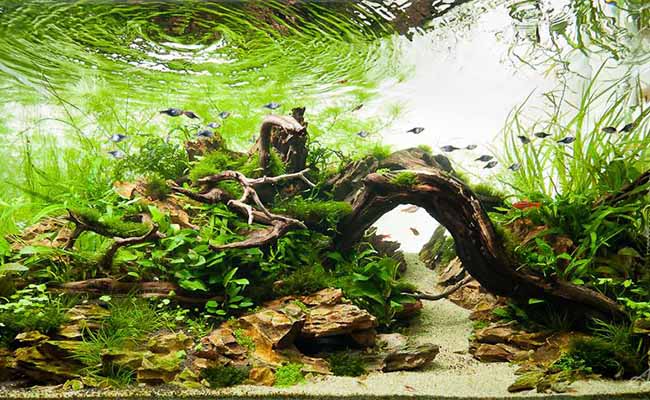 |
Dutch Style
| It’s one of the old aquascaping styles that focuses on the arrangement of plants according to their height. This style was conceived at the beginning of the 20th century to create a central focal point. The colorful plantation is the primary characteristic of it. The lower plants are usually placed at the front, while taller ones are at the back. It creates a sense of depth in the tank. Although it is beautiful, it does not appear natural. It requires high maintenance as it has stem plants. |
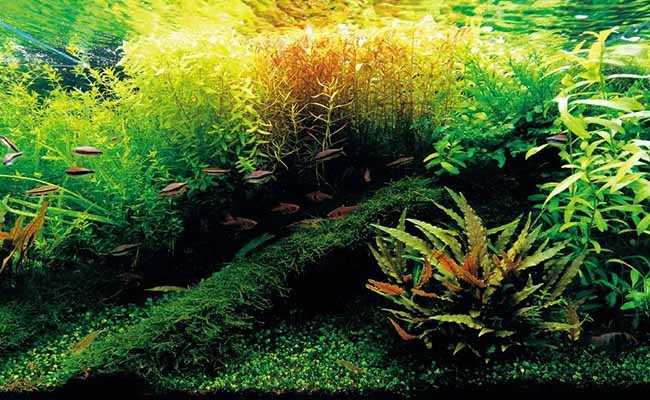 |
Jungle Style
| It is one of the most suitable aquascaping styles for African water ferns. It’s a combination of Japanese style and Dutch style. Unlike inspiration styles, it does not have any pattern. Wild appearance and lush and dense foliage are the primary features of this style. African water ferns are often mixed with other ferns to create it. It represents a sense of depth and natural chaos. | 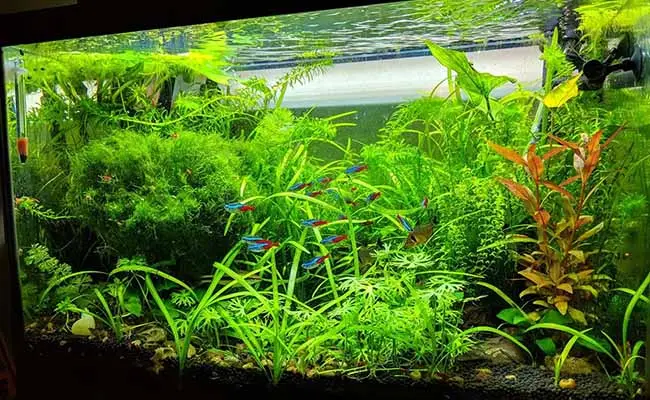 |
Riparium Style
| An African water fern is among the best options for creating a riparium. A riparium replicates the edges of rivers and streams. It includes both water and land. Riparium style has both emerged and submerged plants. Bolbitis heudelotii is the best in replicating river or lake parts, as it grows in submerged conditions. Attach it with some rock or wood and place it under fast-moving water. |
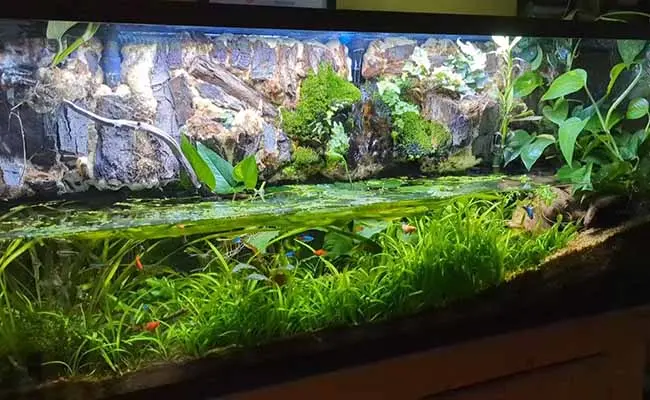 |
Bolbitis Heudelotii Aquascaping Tips
Here are some aquascaping tips that will help you create your desired design.
- Buy long aquascaping tools, as African ferns can grow larger and are suitable for large and deep tanks.
- Select plants that complement your style alongside Bolbitis heudelotii, i.e., swords, crypts, anubias, and Cyprus helferi.
- Although African ferns do not need substrate, However, for complementing plants, increase substrate depth. It’ll allow you to create terrain and slopes.
- Don’t cover its rhizome with the substrate.
How to Plant Bolbitis Heudelotii in Aquariums?
Bolbitis heudelotii is a low-care plant that creates a scenic view in a tank. Although it requires low maintenance, follow a procedure for successful propagation.
Plant Preparation
- Rinse the rhizome and remove harmful organisms attached to the rhizome or plant.
- Remove the decaying or damaged leaves from it.
Plantation
- Use thread or aquarium-safe glue, and tie its rhizome with rock, driftwood, or other hardscaping decoration.
Placement
- Submerge the rock or driftwood where the water flow is higher.
- Also, ensure that it receives proper nutrients and desired light.
- Don’t grow too many plants around it, and ensure the plant is not a fish excrement site. Both harm the plant.
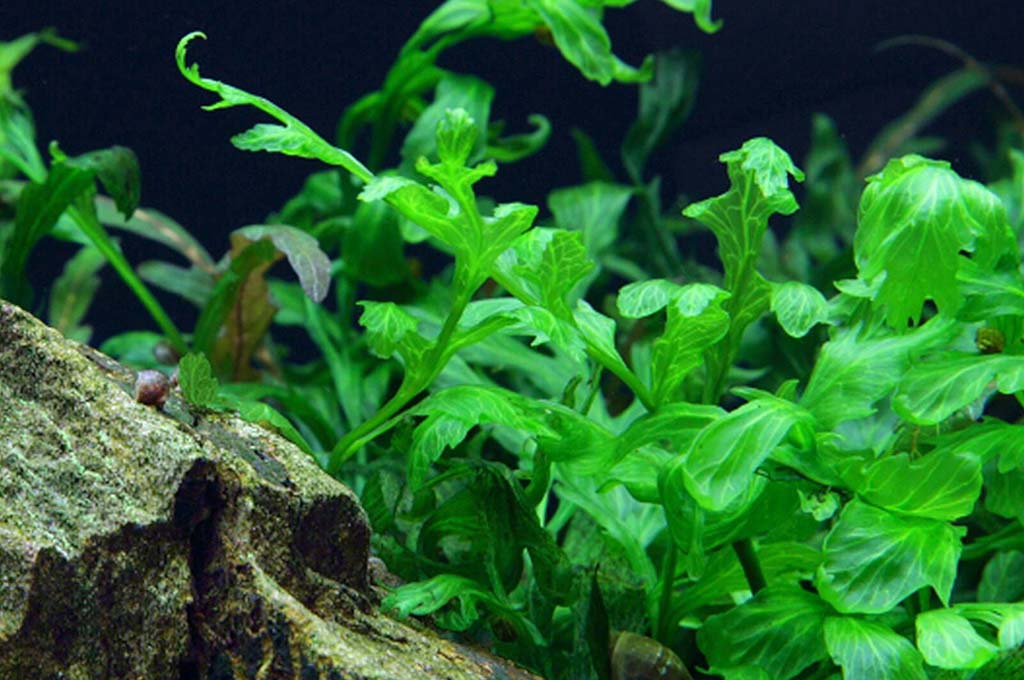
Bolbitis heudelotii aquascape
CO2
- It does not need complementary CO2. However, if you want fast growth, supply complementary CO2 once a week.
Emersed Bolbitis heudelotii
- Have a paludarium, i.e., water and land areas, as it provides submerged and emergent conditions.
- Create a shallow water pond with a proper misting system.
- Attach the plant to the rock and place the rhizome in water by keeping the rest of the plant out of the water.
- Provide moderate lighting, as they require less light in emersed conditions.
Care Sheet
| Feature | Optimal Value |
| Water temperature | 20 to 28°C |
| Water hardness | Soft moderately acidic |
| pH | 5.0 to 7.0 |
| Flow rate | high |
| Growth media | Rock or wood |
| Light spectrum | Wide range, i.e., low to moderate |
| Light | 3 watts per gallon |
Maintenance
| Regularly prune the plant. | Keep an eye on algae growth as it erupts in intense lighting conditions. | Ensure high humidity. |
| If you observe a nutrient deficiency, apply liquid fertilizer. | If you want another African water fern, cut the large rhizome into two or more parts and grow them separately. | |
Bolbitis Difformis vs Bolbitis Heudelotii
| Features | Bolbitis Difformis | Bolbitis Heudelotii |
| Common Name | Water Sprite, Water Fern | African Water Fern |
| Family | Dryopteridaceae | Lomariopsidaceae |
| Origin | Southeast Asia | West Africa |
| Leaf shape | Finely divided, feathery | Broad, deeply lobed |
| Size | Smaller, delicate fronds | Larger, more robust fronds |
| Water temperature | 18-28°C | 20-28°C |
| pH | 6.0-7.5 | 5.0-7.0 |
| Growth Habitat | Submerged, emerged | Preferably submerged |
To Sum Up
African fern, or Bolbitis heudelotii, is a true water fern that grows in fast-moving freshwater bodies. Natural, grows in submerged conditions. This beautiful fern is among the best aquascaping options. They are used for creating nature aquariums, riparium, and jungle styles.
Use a proper way to grow this midground plant in your tank. Bolbitis Difformis differs from Bolbitis Heudelotii in size, shape, water parameters, pH, etc. Choose the right one before building your aquascaping.
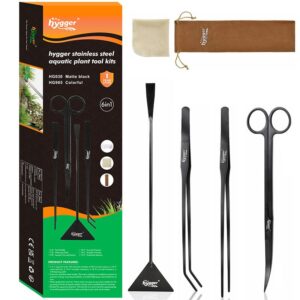
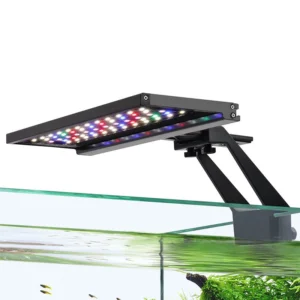
Leave a comment